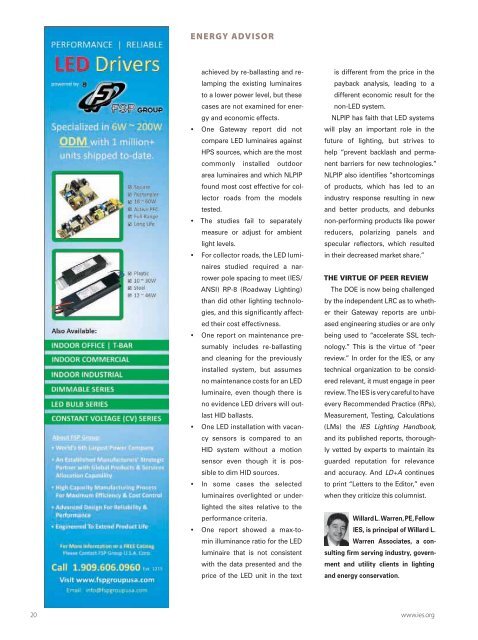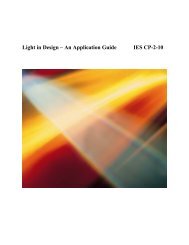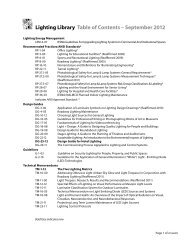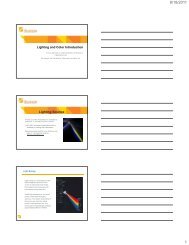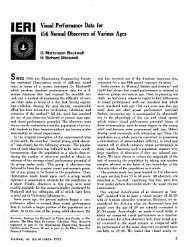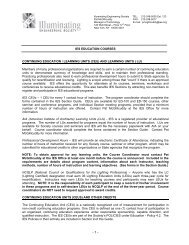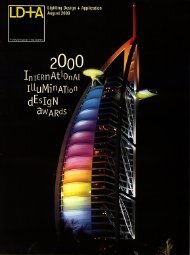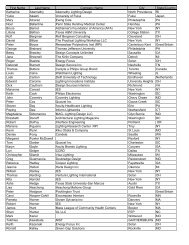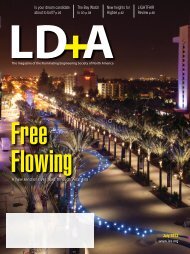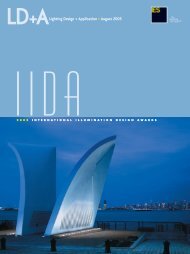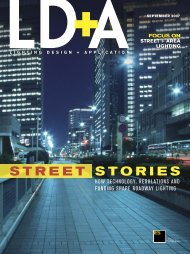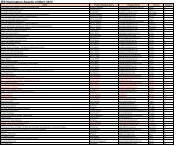faces of the future - Illuminating Engineering Society
faces of the future - Illuminating Engineering Society
faces of the future - Illuminating Engineering Society
You also want an ePaper? Increase the reach of your titles
YUMPU automatically turns print PDFs into web optimized ePapers that Google loves.
ENERGY ADVISOR<br />
FSP Group<br />
1/3<br />
Vertical Ad<br />
achieved by re-ballasting and relamping<br />
<strong>the</strong> existing luminaires<br />
to a lower power level, but <strong>the</strong>se<br />
cases are not examined for energy<br />
and economic effects.<br />
• One Gateway report did not<br />
compare LED luminaires against<br />
HPS sources, which are <strong>the</strong> most<br />
commonly installed outdoor<br />
area luminaires and which NLPIP<br />
found most cost effective for collector<br />
roads from <strong>the</strong> models<br />
tested.<br />
• The studies fail to separately<br />
measure or adjust for ambient<br />
light levels.<br />
• For collector roads, <strong>the</strong> LED luminaires<br />
studied required a narrower<br />
pole spacing to meet (IES/<br />
ANSI) RP-8 (Roadway Lighting)<br />
than did o<strong>the</strong>r lighting technologies,<br />
and this significantly affected<br />
<strong>the</strong>ir cost effectivness.<br />
• One report on maintenance presumably<br />
includes re-ballasting<br />
and cleaning for <strong>the</strong> previously<br />
installed system, but assumes<br />
no maintenance costs for an LED<br />
luminaire, even though <strong>the</strong>re is<br />
no evidence LED drivers will outlast<br />
HID ballasts.<br />
• One LED installation with vacancy<br />
sensors is compared to an<br />
HID system without a motion<br />
sensor even though it is possible<br />
to dim HID sources.<br />
• In some cases <strong>the</strong> selected<br />
luminaires overlighted or underlighted<br />
<strong>the</strong> sites relative to <strong>the</strong><br />
performance criteria.<br />
• One report showed a max-tomin<br />
illuminance ratio for <strong>the</strong> LED<br />
luminaire that is not consistent<br />
with <strong>the</strong> data presented and <strong>the</strong><br />
price <strong>of</strong> <strong>the</strong> LED unit in <strong>the</strong> text<br />
is different from <strong>the</strong> price in <strong>the</strong><br />
payback analysis, leading to a<br />
different economic result for <strong>the</strong><br />
non-LED system.<br />
NLPIP has faith that LED systems<br />
will play an important role in <strong>the</strong><br />
<strong>future</strong> <strong>of</strong> lighting, but strives to<br />
help “prevent backlash and permanent<br />
barriers for new technologies.”<br />
NLPIP also identifies “shortcomings<br />
<strong>of</strong> products, which has led to an<br />
industry response resulting in new<br />
and better products, and debunks<br />
non-performing products like power<br />
reducers, polarizing panels and<br />
specular reflectors, which resulted<br />
in <strong>the</strong>ir decreased market share.”<br />
THE VIRTUE OF PEER REVIEW<br />
The DOE is now being challenged<br />
by <strong>the</strong> independent LRC as to whe<strong>the</strong>r<br />
<strong>the</strong>ir Gateway reports are unbiased<br />
engineering studies or are only<br />
being used to “accelerate SSL technology.”<br />
This is <strong>the</strong> virtue <strong>of</strong> “peer<br />
review.” In order for <strong>the</strong> IES, or any<br />
technical organization to be considered<br />
relevant, it must engage in peer<br />
review. The IES is very careful to have<br />
every Recommended Practice (RPs),<br />
Measurement, Testing, Calculations<br />
(LMs) <strong>the</strong> IES Lighting Handbook,<br />
and its published reports, thoroughly<br />
vetted by experts to maintain its<br />
guarded reputation for relevance<br />
and accuracy. And LD+A continues<br />
to print “Letters to <strong>the</strong> Editor,” even<br />
when <strong>the</strong>y criticize this columnist.<br />
Willard L. Warren, PE, Fellow<br />
IES, is principal <strong>of</strong> Willard L.<br />
Warren Associates, a consulting<br />
firm serving industry, government<br />
and utility clients in lighting<br />
and energy conservation.<br />
20 www.ies.org


